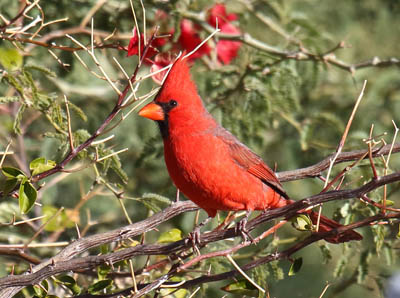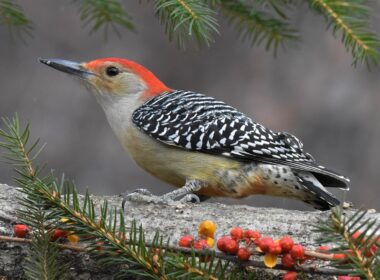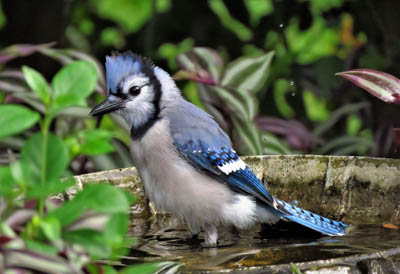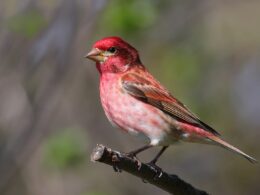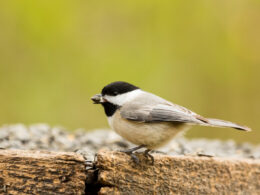Last Updated on January 26, 2024 by Greg Gillson
Hummingbirds show up in spring, buzz around the yard for a few weeks, and are gone. Even if you live in an area where hummingbirds nest, the adult males disappear in mid-summer. Where did they come from? Where did they go? This article answers that question for 8 of the most widespread hummingbirds in the United States and Canada.
Where do hummingbirds migrate to?
Hummingbirds migrate to where the flowers are blooming so they can eat nectar and insects! For many hummingbirds that breed in the United States that means migrating to Mexico for the winter. Some of our western hummingbirds are resident, staying in the same place year-round.
Let’s follow 8 common and widespread North American hummingbird species throughout the year. Let’s find out where they migrate to each season.
Where do Ruby-throated Hummingbirds migrate to?
Winter range: The winter range of Ruby-throated Hummingbird includes a very few birds from Florida to southern Texas. Primarily, though, the winter range is the entire south half of Mexico south through Central America to Costa Rica and Panama.
Spring migration: Birds leave their wintering grounds in January and begin moving north. Ruby-throated Hummingbirds start reaching the southern United States the first week of March. They reach the Northeast US in early April; the upper Midwest by late April. By early May they have reached Canada.
Males migrate separately from females and about 2 weeks ahead.
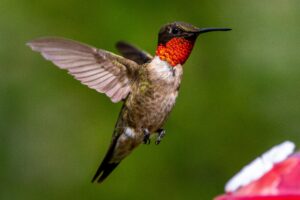
In spring migration many Ruby-throated Hummingbirds fly over 500 miles non-stop across the Gulf of Mexico to reach the southeastern United States from Mexico. Birds depart the northern Yucatan and may reach landfall anywhere between Texas and Florida,… up to 18 hours later!
Summer breeding range: Ruby-throated Hummingbirds are the only nesting hummingbirds in the Eastern United States. In fact, they nest east of the 100th meridian in most of the United States and southern Canada to Prince Edward Island. The western edge of their range extends northward from eastern Texas to eastern North Dakota. The southern boundary for nesting is from eastern Texas all the way to Florida. They also extend a bit westward in southern Canada to central Alberta.
Breeding habitat: Ruby-throated Hummingbirds are found in lowland gardens and woodland edges. They show a preference for stream borders. They do not handle cold weather as well as some of the hummingbird species found in the mountains of the West.
Fall migration: Adult males may start moving south in August. Immature birds lag behind and may remain in the United States until November. It seems many birds tend to migrate to Texas and follow the eastern coastal lands of Mexico south. Fewer birds fly across the Gulf of Mexico in fall than during the spring return migration.
 |
|
Rufous Hummingbird
Photo by Greg Gillson
|
Where do Rufous Hummingbirds migrate to?
Winter range: Rufous Hummingbirds winter in southwestern Mexico south to the States of Guerrero and Veracruz. A very few also winter regularly in the southeastern US.
Spring migration: Males migrate a week or 2 ahead of the females. Males may arrive along the Oregon and Washington coast by mid-February. Rufous Hummingbirds reach Southeast Alaska by mid-April. They may not arrive in more interior and snow-bound mountains until May.
Summer breeding range: This is the most northerly-breeding hummingbird in the world. Rufous Hummingbirds nest in southern Alaska and southern Yukon south to southwestern Alberta and western Montana, northern and western Idaho and westward to southwestern Oregon.
Breeding habitat: These birds breed in openings in coniferous mountain forests, clearings, stream sides, lowland brushy areas.
Fall migration: Adult males disappear from breeding areas by July. Move up into the mountains and follow them southward in August. Females and immature Rufous Hummingbirds look similar to Allen’s Hummingbird, so determining fall migration for them in California is more difficult without trapping. Wanders regularly to the coastal areas of the Southeastern United States, where they sometimes spend the winter.
Where do Black-chinned Hummingbirds migrate to?
Winter range: Most Black-chinned Hummingbirds winter in western Mexico from Sonora south to Guerrero. Rare in Gulf Coast States.
Spring migration: Black-chinned Hummingbirds migrate north into Arizona and Texas in early March, California in late March. They arrive in Colorado and eastern Washington in mid-April.
Summer breeding range: Black-chinned Hummingbirds breed from southern British Columbia southward through eastern Washington and Oregon, throughout California. They also nest from Idaho to Colorado and south into Texas. They breed across the entire width of extreme northern Mexico.
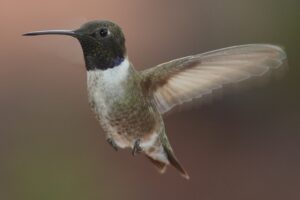
Breeding habitat: Black-chinned Hummingbirds are partial to dry oak woodlands, pinyon-juniper woodlands, and sycamore riparian zones.
Fall migration: Black-chinned Hummingbirds depart most of their breeding range by the last week of September. They depart Arizona by the end of October and Texas in November.
Where do Broad-tailed Hummingbirds migrate to?
Winter range: Broad-tailed Hummingbirds winter in central and southwestern Mexico. Some winter in coastal Texas.
Spring migration: By the first week of March Broad-tailed Hummingbirds have returned to Arizona and New Mexico. They arrive in Nevada and Utah in mid-March. They arrive in Colorado the 2nd week of April, Idaho in late April.
Summer breeding range: Broad-tailed Hummingbirds breed from southern Idaho and Wyoming south from Nevada to Colorado, then southward to northern Arizona, New Mexico, western Texas. These hummingbirds breed in the mountains of Mexico to Mexico City.
Breeding habitat: Broad-tailed Hummingbirds nest in dry mountain forests and aspen groves.
Fall migration: Broad-tailed Hummingbirds depart Idaho and Nevada in mid-September, Utah and Colorado in October, Arizona and New Mexico by mid-November.
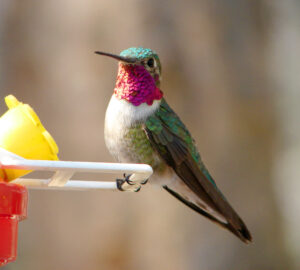
Where do Calliope Hummingbirds migrate to?
Winter range: Calliope Hummingbirds winter in southwestern Mexico to Guerrero State. Some birds very rarely winter in the southeastern United States.
Spring migration: Calliope Hummingbirds migrate through Arizona (where they do not breed) starting in mid-March. Early birds reach Nevada in mid-March and Oregon in late March. The first spring migrants arrive in Idaho during the 1st week of April.
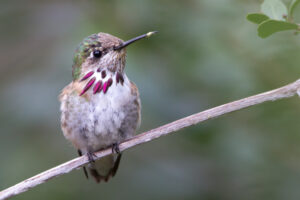
Summer breeding range: These birds nest from central British Columbia and southwestern Alberta, south through Washington, Oregon, Nevada, California to northern Baja California. Calliope Hummingbirds also nest in Idaho, western Montana, Utah and western Colorado.
Breeding habitat: Mountainous regions generally above 3500 feet of elevation. Breeds in riparian meadows and willow thickets.
Fall migration: Calliope Hummingbirds follow blooming mountain flowers southward. They migrate south through many areas where they do not breed. They depart Idaho and Nevada in late September. Some depart Oregon as late as mid-October. Birds migrate through Colorado primarily from July to the 3rd week September. Birds migrate through Arizona and New Mexico from mid-July to early October.
Anna’s Hummingbird
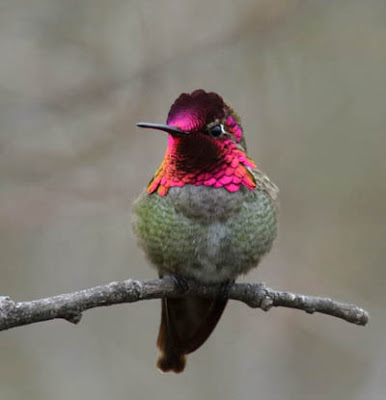 |
|
Anna’s Hummingbird
Photo by Greg Gillson
|
Special case: A resident hummingbird, not migratory. Formerly (60+ years ago) restricted to California and northwestern Baja California. But it has been expanding its range since at least the 1970’s by following hummingbird feeders and non-native flowering plants in the fall to establish new breeding outposts.
Winter range: As the breeding range, below, plus more of Baja California, southern Arizona, northern Sonora. Occasionally to New Mexico.
Spring migration: None, as it breeds in winter and very early spring (see below).
Summer breeding range: Anna’s Hummingbirds nest (late December to March) in lowlands of California south to northwestern Baja California. They reach western and southern Nevada. Recently expanded to western Oregon, western Washington and southwestern British Columbia; also expanded into western and southern Arizona.
Breeding habitat: Anna’s Hummingbirds live in residential and gardens in lowlands, oak and chaparral regions.
Fall migration: Even though Anna’s Hummingbirds are primarily resident, some birds disperse eastward into the desert Southwest starting in May. They then make their way back in December, although some individuals stay to create a new breeding location.
Allen’s Hummingbird
Special case: Allen’s Hummingbirds are almost completely restricted to nesting on the California coast. The northern California population is migratory. The southern California population of Allen’s Hummingbirds is non-migratory.
Winter range: The migratory form of Allen’s Hummingbirds winter from northwestern Mexico to Sinaloa, centered around Mexico City.
Spring migration: Allen’s Hummingbirds start noticeably increasing in numbers in southern California from January to March. Early Allen’s Hummingbirds arrive in Oregon in mid-February.

Summer breeding range: The migratory form of Allen’s Hummingbirds breed from southwestern Oregon (barely 35 miles into the state) south along the coast to Ventura County, California. There is a resident subspecies of Allen’s Hummingbird found on islands off southern California and recently (last 30 years or so, and increasingly) on the mainland from Los Angeles to San Diego (first nesting 2001). They have become rather common the last 10 years or so in San Diego.
Breeding habitat: Allen’s Hummingbirds breed in coastal chaparral and low riparian woodlands.
Fall migration: Allen’s Hummingbirds completely depart their tiny breeding range in Oregon in August. Males leave in June. Female and immature Allen’s Hummingbirds are identical to Rufous Hummingbirds of the same age except for tail feather measurements. Only adult males are easily identified by sight. Males of both species migrate south early in summer. Females and immatures seen in fall in California are mostly unidentified as to both species and as to whether they are late migrants or the resident Allen’s. Winter female or immature birds in southern California are assumed to be Allen’s, but Rufous will be migrating through for “spring” in late January.
Costa’s Hummingbird
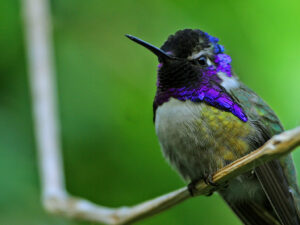
Special case: Generally nomadic in the desert Southwest, following blooming flowers, Costa’s Hummingbirds in San Diego County of southwestern-most California nest in the interior low desert in early spring (February to April). They nest in coastal slope chaparral and coastal sage scrub from April to June. In summer and fall, then, they may migrate southward well into southwestern Mexico.
Winter range: At least a few Costa’s Hummingbirds winter over most of their breeding range (see below), from southern California and southwestern Arizona, southward into southwestern Mexico. This is hard to determine, as late winter is the breeding season in the desert regions. So late summer and fall is the non-breeding season they may move.
Spring migration: Desert nesting birds in San Diego arrive on territory in December. Chaparral nesting birds in San Diego arrive in April.
Summer breeding range: Costa’s Hummingbirds nest (February to June) from central California, southern Nevada, southwestern Utah, to southern Baja California including nearshore Islands from Santa Barbara southward. They also breed from southern Arizona and southwestern New Mexico into Sonora and Sinaloa.
Breeding habitat: Costa’s Hummingbirds are found in California chaparral habitat and Mojave and Sonoran Deserts. They nest in desert shrubs and cacti (palo verde and ocotillo).
Fall migration: In Anza-Borrego Desert (San Diego County) nesting birds depart the desert in June. Some Costa’s Hummingbirds migrate southward into Mexico.
Wrapping Up
Hummingbirds, despite their tiny size and incredible endurance, migrate south for the winter for several key reasons:
Food Availability:
- Main factor: Their primary food source, nectar from flowers, becomes scarce or disappears altogether in many parts of their northern breeding grounds during the fall and winter months.
- Adapting to changing seasons: As flowers dwindle with shorter days and cooler temperatures, hummingbirds migrate to areas with more consistent and abundant nectar sources, ensuring their survival and ability to replenish energy reserves.
Energy Conservation:
- Cold weather challenges: Hummingbirds have extremely high metabolic rates to maintain their body temperature and power their rapid wingbeats. Colder winter temperatures require them to expend even more energy for thermoregulation, making survival difficult.
- Migration as an energy-saving strategy: Traveling south to warmer climates reduces their need to constantly regulate their body temperature, allowing them to conserve precious energy for other essential activities like foraging and breeding.
Breeding and Competition:
- Seasonal variations: Hummingbirds typically breed in the spring and summer when food resources are plentiful in their northern ranges. As fall approaches, resources decline, and competition for remaining food sources intensifies.
- Southern sanctuaries: By migrating south, they avoid the harsh competition and dwindling resources in their breeding grounds, finding more favorable conditions for raising their young in warmer areas with abundant food.
Instinctive Behavior:
- Inherited migratory patterns: The urge to migrate is a deeply ingrained instinct passed down through generations, even though individual hummingbirds might never have experienced the cold northern winters themselves.
- Navigational prowess: Possessing remarkable navigational abilities, they utilize clues like the Earth’s magnetic field, the position of the sun, and celestial bodies to guide them on their long journeys south.
Frequently Asked Questions
Do hummingbirds return to the same place every year?
Hummingbirds do have a remarkable ability to return to the same general area where they hatched or previously nested, although they may not pinpoint the exact same spot or nest. Here’s what we know:
Strong Homing Instinct:
- Research suggests they possess a strong homing instinct, aided by their excellent spatial memory and possibly even the Earth’s magnetic field.
- Banding studies have shown individuals returning to the same feeders or gardens year after year, sometimes within just a few days of their arrival.
Returning to Familiar Areas:
- While they might not remember the exact location of their nest, they likely recall features like landscapes, landmarks, and flower patches within their breeding territory.
- This familiarity provides navigational cues and helps them locate suitable nesting sites and reliable food sources.
Factors Affecting Return:
- Availability of resources: If their previous nesting area lacks sufficient food or suitable nesting sites, they might explore other nearby locations within their familiar territory.
- Competition: If competition for resources gets intense, they might seek alternative nesting locations to optimize their chances of success.
- Habitat disturbances: Major changes to their habitat, like development or deforestation, can disrupt their ability to return to previous locations.
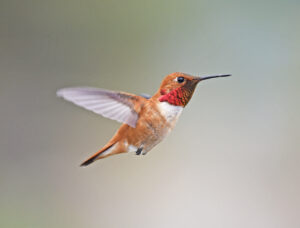
What are the dangers for hummingbirds on migration?
Hummingbirds face a multitude of dangers during their epic migrations, navigating from their breeding grounds in North America to their wintering sites in Central and South America. Here are some of the key challenges they encounter:
Habitat Loss and Degradation:
- Deforestation: The destruction of forests along their migratory routes reduces crucial sources of food and shelter, leaving them vulnerable and exhausted.
- Urban development: Expanding cities, roads, and other human infrastructure fragment natural habitats, making navigation and finding resources more difficult.
- Pesticide use: Insecticides applied to gardens and agricultural fields can harm insect populations, a critical food source for hummingbirds during migration.
Predation:
- Birds of prey: Hawks, owls, and falcons target hummingbirds in mid-flight, especially during their vulnerable crossing of the Gulf of Mexico.
- Domestic cats: Free-roaming cats pose a significant threat to hummingbirds near feeders and gardens, particularly during stopovers where they rest and refuel.
- Snakes and reptiles: These predators can climb trees and raid hummingbird nests, stealing eggs or chicks.
Weather:
- Extreme weather events: Hurricanes, storms, and droughts can disrupt their migration routes, leading to exhaustion, starvation, and dehydration.
- Collisions with windows and power lines: Hummingbirds attracted to feeders or brightly lit buildings can accidentally collide with glass panes or power lines, leading to injuries or death.

Do hummingbirds recognize humans?
The question of whether hummingbirds recognize individual humans is a fascinating one, but the answer is a bit complex and nuanced. While they may not possess the same level of facial recognition as some primates or even other bird species, there’s growing evidence that suggests they can develop a level of familiarity or positive association with humans who consistently provide them with food and a safe environment.
Here’s what we know:
Signs of Familiarity:
- Regular visitors: Hummingbirds who frequent the same feeder or garden over time might become more comfortable with the presence of humans who maintain those feeding areas.
- Less skittish behavior: They might show less fear or hesitation towards familiar humans compared to strangers, approaching feeders more readily and even venturing closer to observe or interact.
- Conditional responses: Some anecdotal reports suggest hummingbirds remembering individuals who offer them sugary water treats or hand-held feeders, associating them with a positive experience and readily approaching them.
Limitations of Recognition:
- Distinguishing features: Hummingbirds primarily rely on sight and sound for identification, but human facial features might not be as distinct for them compared to other birds.
- Individual recognition: While they might recognize familiar individuals in a general sense, differentiating between humans with subtle variations in appearance is likely more challenging.
- Focus on resources: Ultimately, their primary motivation for approaching humans is likely driven by the availability of food and a safe feeding environment, rather than individual recognition in the strictest sense.
Read next: When to put out and take down your hummingbird feeders
Have you read? Steal your neighbor’s hummingbirds!



